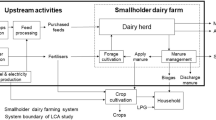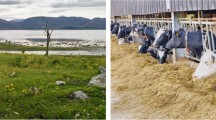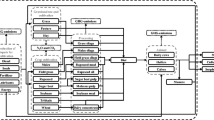Abstract
Purpose
This study examines the inter-annual variability of production data in an organic dairy farm and its effect on the estimation of product-related greenhouse gas emissions (GHG) using a detailed material flow model. It is believed that the examination of only one production year may not adequately reflect temporal representativeness and may therefore lead to unreliable results. The current study also provides a method to deal with variability when temporal representativeness cannot be ensured.
Methods
All material flows related to milk production from six consecutive milk years in an organic dairy farm in northern Germany were analysed. The milk yield of the 75 to 91 cows varied between 5418 and 7102 kg energy corrected milk (ECM) per cow and year. GHG emissions were estimated using calculation guidelines from the International Dairy Federation (IDF) and the Intergovernmental Panel on Climate Change (IPCC). Emissions were calculated in the Flow Analysis and Resource Management (FARM) model ensuring mass balances for nitrogen and phosphorous in every subsection of the model. Based on the variability of crop yields, the number of years for representative average data was calculated as well as an uncertainty when only a limited number of years was available.
Results and discussion
Estimated GHG emissions varied between 0.88 and 1.09 kg CO2-eq kg−1 ECM−1 (mean, standard deviation of the mean = 0.97 and 0.07 kg CO2-eq kg−1 ECM−1). Emissions from ruminant digestion had the highest contribution (50.9 ± 2.3) percent in relation to overall product-related GHG emissions. Direct emissions from soil showed the highest coefficient of variation (36%) due to simultaneous changes in fertilization amount, crop yield and milk yield which showed no significant direct relationship. The number of years needed to be assessed for representative average yields was between 27 and 215 years for clover grass and maize silage, respectively. When performing a sensitivity analysis based on the variability of crop yields, the assessed farm showed reliable results with average data of at least 4 years.
Conclusions
Temporal representativeness should be dealt with explicitly in GHG assessments for dairy farming. If the representativeness of crop yields cannot be ensured, an uncertainty bandwidth of the results based on variability of yields can provide a basis for comparing different farms or farming systems. This approach could also be extended to other variabilities in dairy farming for more reliability of results.





Similar content being viewed by others
References
Allen MS (2000) Effects of diet on short-term regulation of feed intake by lactating dairy cattle. J Dairy Sci 83(7):1598–1624
Althaus HJ, Chudacoff M, Hischier R, Jungbluth N, Osses M, A. P (2007) Life Cycle Inventories of Chemicals. Final report ecoinvent data v2.0 No. 8. Swiss Centre for Life Cycle Inventories, Dübendorf
Brade VW, Dammgen U, Lebzien P, Flachowsky G (2008) Milk production and emissions of greenhouse gases. Berichte Uber Landwirtschaft 86(3):445–460
Cederberg C, Mattson B (2000) Life cycle assessment of milk production—a comparison of conventional and organic farming. J Clean Prod 8(1):49–60
Cederberg C, Stadig M (2003) System expansion and allocation in life cycle assessment of milk and beef production. Int J Life Cycle Assess 8(6):350–356
Dämmgen U, Hutchings NJ (2008) Emissions of gaseous nitrogen species from manure management: a new approach. Environ Pollut 154(3):488–497
EC (2007) No 834/2007 of 28 June 2007 on organic production and labelling of organic products and repealing Regulation (EEC) No 2092/91
EC (2009) No 1307/2013 of the European Parliament and of the Council. EstablishingEstablishing rules for direct payments to farmers under support schemes within the framework of the common agricultural policy and repealing Council Regulation (EC) No 637/2008 and Council Regulation (EC) No 73/2009
Eide MH (2002) Life cycle assessment (LCA) of industrial milk production. Int J Life Cycle Assess 7(2):115–126
Ellis JL, Bannink A, France J, Kebreab E, Dijkstra J (2010) Evaluation of enteric methane prediction equations for dairy cows used in whole farm models. Global Change Biology 16(12):3246–3256
FAOSTAT (2015) Food and Agriculture Organization of the United Nations. Statistics, Rome, Italy. Retrieved August 15, 2015, from http://faostat.fao.org/
Flysjo A, Cederberg C, Henriksson M, Ledgard S (2011) How does co-product handling affect the carbon footprint of milk? Case study of milk production in New Zealand and Sweden. Int J Life Cycle Assess 16(5):420–430
Frank H, Schmid H, Huelsbergen KJ (2013) Energie- und Treibhausgasbilanz milchviehhaltender Landwirtschaftsbetriebe in Süd- und Westdeutschland. in Huelsbergen KJ, Rahmann G (2013) (eds) Klimawirkungen und Nachhaltigkeit ökologischer und konventioneller Betriebssysteme – Untersuchungen in einem Netzwerk von Pilotbetrieben Braunschweig, 383 p, Thünen Report 8
Frank H, Schmid H, Hülsbergen KJ (2015) Energie- und Treibhausgasbilanz der Milchviehhaltung – Untersuchungen im Netzwerk der Pilotbetriebe. Thünen Rep 29:25–48 abstract in English
Gardenas AI, Agren GI, Bird JA, Clarholm M, Hallin S, Ineson P, Katterer T, Knicker H, Nilsson SI, Nasholm T, Ogle S, Paustian K, Persson T, Stendahl J (2011) Knowledge gaps in soil carbon and nitrogen interactions—from molecular to global scale. Soil Biol Biochem 43(4):702–717
GfE (2001) Gesellschaft für Ernährungsphysiologie der Haustiere / Ausschuss für Bedarfsnormen: Empfehlungen zur Energie- und Nährstoffversorgung der Milchkühe und Aufzuchtrinder, vol 8. Energie- und Nährstoffbedarf landwirtschaftlicher Nutztiere. DLG-Verl., Frankfurt am Main
L Gruber, M Pries, H Spiekers, FJ Schwarz, W Staudacher (2006) Schätzung der Futteraufnahme bei der Milchkuh. DLG-Informationen 1/2006. Retrieved August 15, 2015, from http://2015.dlg.org/fileadmin/downloads/fachinfos/futtermittel/futteraufnahme_milchkuh06.pdf
Guerci M et al (2013) Parameters affecting the environmental impact of a range of dairy farming systems in Denmark, Germany and Italy. J Clean Prod 54:133–141
Guerci M et al (2014) Effect of summer grazing on carbon footprint of milk in Italian Alps: a sensitivity approach. J Clean Prod 73:236–244
Haas G, Wetterich F, Geier U (2000) Life cycle assessment framework in agriculture on the farm level. Int J Life Cycle Assess 5(6):345–348
IDF (2010) A common carbon footprint approach for dairy—the IDF guide to standard lifecycle assessement methodology for the dairy sector. Bulletin 445/2010, International Dairy Federation
ILCD (2010) European Commission–Joint Research Centre–Institute for Environment and Sustainability: International Reference Life Cycle Data System (ILCD) handbook—general guide for life cycle assessment—detailed guidance. First edition March 2010. EUR 24708 EN. Luxembourg. Publications Office of the European Union; 2010
IPCC (2006) IPCC guidelines for national greenhouse gas inventories, Prepared by the National Greenhouse Gas Inventories Programme. IGES, Japan
ISO 14040 (2006) International Organization for Standardization, Geneva, Switzerland, In: Environmental management—life cycle assessment—principles and framework. https://www.iso.org/standard/37456.html
Jeroch H, Drochner W, Simon O (1999) Ernährung landwirtschaftlicher Nutztiere: Ernährungsphysiologie, Futtermittelkunde, Fütterung. UTB für Wissenschaft
Koerber GR, Edwards-Jones G, Hill PW, Canals LMI, Nyeko P, York EH, Jones DL (2009) Geographical variation in carbon dioxide fluxes from soils in agro-ecosystems and its implications for life-cycle assessment. J Appl Ecol 46(2):306–314
Koesling M, Ruge G, Fystro G, Torpe T, Hansen S (2015) Embodied and operational energy in buildings on 20 Norwegian dairy farms—introducing the building construction approach to agriculture. Energ Build 108:330–345
Köhler W et al (2012) Biostatistik. Eine Einführung für Biologen und Agrarwissenschaftler. Springer-Lehrbuch. Berlin [u.a.], Springer: Online-Ressource (XII, 334 S)
KTBL (2004) Kuratorium für Technik und Bauwesen in der Landwirtschaft e.V.: Betriebsplanung Landwirtschaft 2004/2005. KTBL-Datensammlung. Daten für die Betriebsplanung in der Landwirtschaft. 19., Aufl. edn. Landwirtschaftsvlg Münster, Münster, Westf
KTBL (2014) KTBL-Dieselbedarf. Online resource for calcuation of diesel fuel demand. http://datenktblde/dieselbedarf/mainhtml
LFL (2012) http://www.lfl.bayern.de/mam/cms07/publikationen/daten/informationen/energieein-sparung_milchviehhaltung-milchgewinnung_lfl-information.pdf. Retrieved 20.1.2016
Meyer U (2005) Fütterung von Kälbern und Jungrindern. In: Brade W, Flachowsky G (eds) Rinderzucht und Milcherzeugung Empfehlungen für die Praxis Braunschweig, pp 127–136 Landbauforschung Völkenrode - FAL Agricultural Research Special Issue 289
Müller-Lindenlauf M, Deittert C, Köpke U (2010) Assessment of environmental effects, animal welfare and milk quality among organic dairy farms. Livest Sci 128(1–3):140–148
Nemecek T, Erzinger S (2005) Modelling representative life cycle inventories for Swiss arable crops. Int J Life Cycle Assess 10(1):68–76
Nemecek T, Kägi T, Blaser S (2007) Life cycle inventories of agricultural production systems. Ecoinvent report version 2.0. Swiss Centre for LCI, ART
Nguyen TLT, Hermansen JE, Mogensen L (2010) Environmental consequences of different beef production systems in the EU. J Clean Prod 18(8):756–766
Novak SM, Fiorelli JL (2010) Greenhouse gases and ammonia emissions from organic mixed crop-dairy systems: a critical review of mitigation options. Agron Sustain Dev 30(2):215–236
Ohm M, Schüler M, Warnecke S, Paulsen H, Rahmann G (2014) Measurement methods on pastures and their use in environmental life-cycle assessment. Org Agr 4(4):325–329
Paulsen HM, Warnecke S, Schmid H, Frank H, Brinkmann J, March S, Koopmann R (2015) Haltungsbedingungen, Tiergesundheits- und Tierwohlparameter und Medikamenteneinsatz in der Milchviehhaltung auf je zwei ökologischen und konventionellen Betrieben sowie Auswirkungen von Optimierungsansätzen zur Verbesserung der Situation der Tiere auf die Klimabilanz der Milcherzeugung. Thünen Rep 29:119–148 abstract in English
Petersen BM, Knudsen MT, Hermansen JE, Halberg N (2013) An approach to include soil carbon changes in life cycle assessments. J Clean Prod 52:217–224
Piatkowski B, Jentsch W, Derno M (2010) New results on methane production and its estimation for cattle. Zuchtungskunde 82(5):400–407
Rösemann C et al (2013) Calculations of gaseous and particulate emissions from German agriculture. 1990–2011; report on methods and data (RMD) submission 2013. Calculations of gaseous and particulate emissions from German agriculture; 2013=1990–2011: Online-Ressource (PDF-Datei: 386 S., 6662 KB)
Schulz F, Warnecke S, Paulsen HM, Rahmann G (2013) Unterschiede der Fütterung ökologischer und konventioneller Betriebe und deren Einfluss auf die Methan-Emissionen aus der Verdauung von Milchkühen. In: Huelsbergen KJ, Rahmann G (eds) Klimawirkungen und Nachhaltigkeit ökologischer und konventioneller Betriebssysteme. Untersuchungen in einem Netzwerk von Pilotbetrieben, Braunschweig p 383, Thünen Report 8
Thoma G, Popp J, Nutter D, Shonnard D, Ulrich R, Matlock M, Kim DS, Neiderman Z, Kemper N, East C, Adom F (2013) Greenhouse gas emissions from milk production and consumption in the United States: a cradle-to-grave life cycle assessment circa 2008. Int Dairy J 31:S3–S14
Thomassen MA, Dalgaard R, Heijungs R, de Boer I (2008a) Attributional and consequential LCA of milk production. Int J Life Cycle Assess 13(4):339–349
Thomassen MA, van Calker KJ, Smits MCJ, Iepema GL, de Boer IJM (2008b) Life cycle assessment of conventional and organic milk production in the Netherlands. Agric Syst 96(1–3):95–107
Warnecke S, Paulsen H, Schulz F, Rahmann G (2014) Greenhouse gas emissions from enteric fermentation and manure on organic and conventional dairy farms—an analysis based on farm network data. Org Agr 4(4):285–293
Windisch W, Kirchgessner M, Kreuzer M (1991) Manure quantity of lactating dairy-cows as affected by varying production intensity. Agribiol Res 44(2–3):170–181
Author information
Authors and Affiliations
Corresponding author
Additional information
Responsible editor: Thomas Jan Nemecek
Rights and permissions
About this article
Cite this article
Schueler, M., Paulsen, H.M., Berg, W. et al. Accounting for inter-annual variability of farm activity data for calculation of greenhouse gas emissions in dairy farming. Int J Life Cycle Assess 23, 41–54 (2018). https://doi.org/10.1007/s11367-017-1307-x
Received:
Accepted:
Published:
Issue Date:
DOI: https://doi.org/10.1007/s11367-017-1307-x




